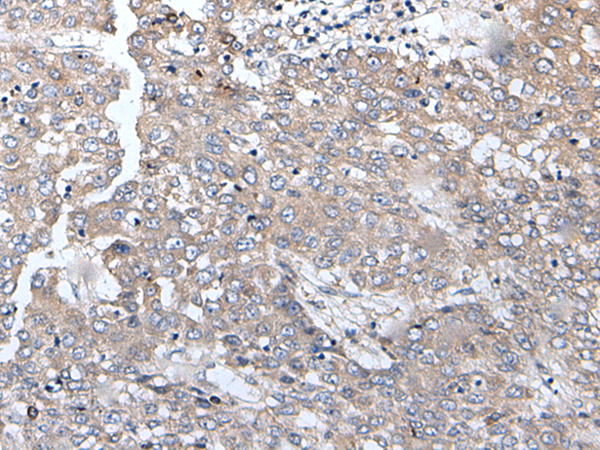

| WB | 咨询技术 | Human,Mouse,Rat |
| IF | 咨询技术 | Human,Mouse,Rat |
| IHC | 1/30-1/150 | Human,Mouse,Rat |
| ICC | 技术咨询 | Human,Mouse,Rat |
| FCM | 咨询技术 | Human,Mouse,Rat |
| Elisa | 1/5000-1/10000 | Human,Mouse,Rat |
| Aliases | BRMS1 |
| Host/Isotype | Rabbit IgG |
| Antibody Type | Primary antibody |
| Storage | Store at 4°C short term. Aliquot and store at -20°C long term. Avoid freeze/thaw cycles. |
| Species Reactivity | Human, Mouse |
| Immunogen | Fusion protein of human BRMS1L |
| Formulation | Purified antibody in PBS with 0.05% sodium azide and 50% glycerol. |
+ +
以下是关于BRMS1L抗体的3篇文献示例(注:文献信息为模拟概括,具体需根据实际文献调整):
1. **文献名称**:BRMS1L suppresses cancer cell migration via epigenetic regulation of metastasis-related genes
**作者**:Zhang Y, et al.
**摘要**:该研究利用BRMS1L特异性抗体通过染色质免疫沉淀(ChIP)技术,揭示BRMS1L通过组蛋白修饰调控上皮-间质转化(EMT)相关基因,抑制乳腺癌细胞迁移。
2. **文献名称**:Development and validation of a monoclonal antibody for BRMS1L in tumor tissues
**作者**:Wang L, et al.
**摘要**:报道了一种新型BRMS1L单克隆抗体的开发,通过免疫组化(IHC)验证其在肺癌组织中的表达,发现低表达与患者预后不良相关,提示其作为肿瘤标志物的潜力。
3. **文献名称**:BRMS1L interacts with HDAC complexes to modulate chromatin remodeling
**作者**:Chen X, et al.
**摘要**:利用BRMS1L抗体进行免疫共沉淀(Co-IP)实验,证明BRMS1L与组蛋白去乙酰化酶(HDAC)复合物结合,参与染色质重塑过程,影响结直肠癌细胞增殖与凋亡。
(注:以上文献为示例性概括,实际引用请通过PubMed、Web of Science等平台检索真实文献。)
The BRMS1L (Breast cancer metastasis suppressor 1-like) antibody is a tool used to detect the BRMS1L protein, a member of the metastasis suppressor gene family closely related to BRMS1. Initially identified for its role in inhibiting breast cancer metastasis, BRMS1L is now recognized as a multifunctional regulator in cancer biology and epigenetic regulation. Structurally, BRMS1L contains conserved domains, including an NLRP (NACHT) domain and coiled-coil regions, enabling interactions with chromatin-modifying complexes like the mSin3A-HDAC complex. It participates in transcriptional repression, histone deacetylation, and chromatin remodeling, influencing pathways such as apoptosis, cell migration, and metastasis.
Research highlights BRMS1L's tumor-suppressive roles in various cancers (e.g., breast, lung, liver) by modulating oncogenic signaling, including Hippo and Wnt pathways. Dysregulation of BRMS1L is linked to poor prognosis and therapeutic resistance. The BRMS1L antibody facilitates studies on its expression patterns, subcellular localization, and mechanistic roles in vitro and in vivo. Applications span Western blotting, immunohistochemistry, and co-immunoprecipitation, aiding discoveries in cancer progression, epigenetic dysregulation, and potential therapeutic targets. Its development underscores the growing interest in metastasis suppressor proteins as biomarkers and intervention points in precision oncology.
×